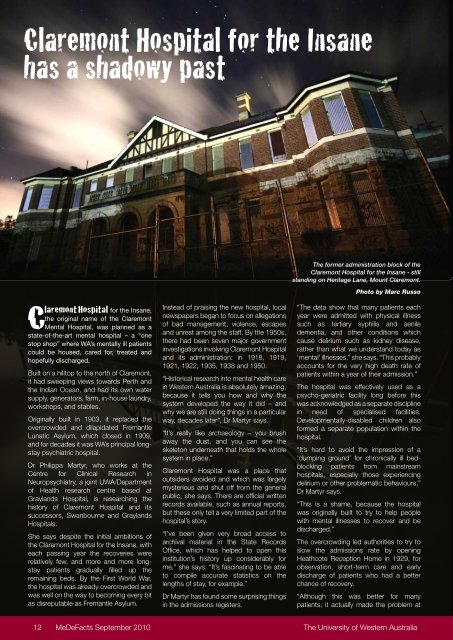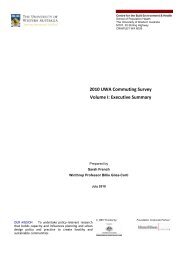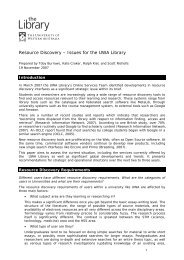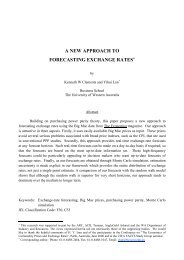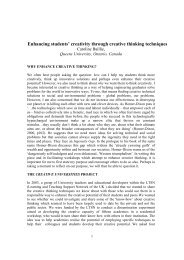MeDeFacts September 2010 - The University of Western Australia
MeDeFacts September 2010 - The University of Western Australia
MeDeFacts September 2010 - The University of Western Australia
Create successful ePaper yourself
Turn your PDF publications into a flip-book with our unique Google optimized e-Paper software.
for the Insane,<br />
the original name <strong>of</strong> the Claremont<br />
Mental Hospital, was planned as a<br />
state-<strong>of</strong>-the-art mental hospital – a “one<br />
stop shop” where WA’s mentally ill patients<br />
could be housed, cared for, treated and<br />
hopefully discharged.<br />
Built on a hilltop to the north <strong>of</strong> Claremont,<br />
it had sweeping views towards Perth and<br />
the Indian Ocean, and had its own water<br />
supply, generators, farm, in-house laundry,<br />
workshops, and stables.<br />
Originally built in 1903, it replaced the<br />
overcrowded and dilapidated Fremantle<br />
Lunatic Asylum, which closed in 1909,<br />
and for decades it was WA’s principal longstay<br />
psychiatric hospital.<br />
Dr Philippa Martyr, who works at the<br />
Centre for Clinical Research in<br />
Neuropsychiatry, a joint UWA/Department<br />
<strong>of</strong> Health research centre based at<br />
Graylands Hospital, is researching the<br />
history <strong>of</strong> Claremont Hospital and its<br />
successors, Swanbourne and Graylands<br />
Hospitals.<br />
She says despite the initial ambitions <strong>of</strong><br />
the Claremont Hospital for the Insane, with<br />
each passing year the recoveries were<br />
relatively few, and more and more longstay<br />
patients gradually filled up the<br />
remaining beds. By the First World War,<br />
the hospital was already overcrowded and<br />
was well on the way to becoming every bit<br />
as disreputable as Fremantle Asylum.<br />
12<br />
Instead <strong>of</strong> praising the new hospital, local<br />
newspapers began to focus on allegations<br />
<strong>of</strong> bad management, violence, escapes<br />
and unrest among the staff. By the 1950s,<br />
there had been seven major government<br />
investigations involving Claremont Hospital<br />
and its administration: in 1918, 1919,<br />
1921, 1922, 1935, 1938 and 1950.<br />
“Historical research into mental health care<br />
in <strong>Western</strong> <strong>Australia</strong> is absolutely amazing,<br />
because it tells you how and why the<br />
system developed the way it did – and<br />
why we are still doing things in a particular<br />
way, decades later”, Dr Martyr says.<br />
“It’s really like archaeology – you brush<br />
away the dust, and you can see the<br />
skeleton underneath that holds the whole<br />
system in place.”<br />
Claremont Hospital was a place that<br />
outsiders avoided and which was largely<br />
mysterious and shut <strong>of</strong>f from the general<br />
public, she says. <strong>The</strong>re are <strong>of</strong>ficial written<br />
records available, such as annual reports,<br />
but these only tell a very limited part <strong>of</strong> the<br />
hospital’s story.<br />
“I’ve been given very broad access to<br />
archival material in the State Records<br />
Office, which has helped to open this<br />
institution’s history up considerably for<br />
me,” she says. “It’s fascinating to be able<br />
to compile accurate statistics on the<br />
lengths <strong>of</strong> stay, for example.”<br />
Dr Martyr has found some surprising things<br />
in the admissions registers.<br />
<strong>The</strong> former administration block <strong>of</strong> the<br />
Claremont Hospital for the Insane - still<br />
standing on Heritage Lane, Mount Claremont.<br />
Photo by Marc Russo<br />
“<strong>The</strong> data show that many patients each<br />
year were admitted with physical illness<br />
such as tertiary syphilis and senile<br />
dementia, and other conditions which<br />
cause delirium such as kidney disease,<br />
rather than what we understand today as<br />
‘mental’ illnesses,” she says. “This probably<br />
accounts for the very high death rate <strong>of</strong><br />
patients within a year <strong>of</strong> their admission.”<br />
<strong>The</strong> hospital was effectively used as a<br />
psycho-geriatric facility long before this<br />
was acknowledged as a separate discipline<br />
in need <strong>of</strong> specialised facilities.<br />
Developmentally-disabled children also<br />
formed a separate population within the<br />
hospital.<br />
“It’s hard to avoid the impression <strong>of</strong> a<br />
‘dumping ground’ for chronically ill bedblocking<br />
patients from mainstream<br />
hospitals, especially those experiencing<br />
delirium or other problematic behaviours,”<br />
Dr Martyr says.<br />
“This is a shame, because the hospital<br />
was originally built to try to help people<br />
with mental illnesses to recover and be<br />
discharged.”<br />
<strong>The</strong> overcrowding led authorities to try to<br />
slow the admissions rate by opening<br />
Heathcote Reception Home in 1929, for<br />
observation, short-term care and early<br />
discharge <strong>of</strong> patients who had a better<br />
chance <strong>of</strong> recovery.<br />
“Although this was better for many<br />
patients, it actually made the problem at<br />
<strong>MeDeFacts</strong> <strong>September</strong> <strong>2010</strong> <strong>The</strong> <strong>University</strong> <strong>of</strong> <strong>Western</strong> <strong>Australia</strong>


